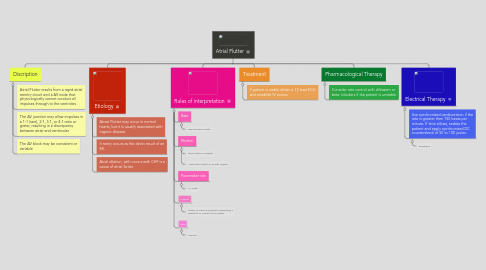Atrial Flutter
por Jerica Smith


1. Discription
1.1. Atrial Flutter results from a rapid atrial reentry circuit and a AV node that physiologically cannot conduct all impulses through to the ventricles
1.2. The AV junction may allow impulses in a 1:1 (rare), 2:1, 3:1, or 4:1 ratio or grater, resulting in a discrepancy between atrial and ventricular
1.3. The AV block may be consistent or variable
2. Etiology
2.1. Atreal Flutter may occur in normal hearts, but it is usually associated with organic disease.
2.2. It rarely occurs as the direct result of an MI.
2.3. Atrial dilation, with occurs with CHF is a cause of atrial flutter
3. Rules of interpretation
3.1. Rate
3.1.1. 250-350 per minute
3.2. Rhythm
3.2.1. atrial rhythm is regular
3.2.2. Ventricular rhythm is usually regular
3.3. Pacemaker site
3.3.1. SA node
3.4. P waves
3.4.1. Flutter (F wave) is present, resembling a sawtooth or picket- fence patter
3.5. QRS
3.5.1. Normal
4. Treatment
4.1. If patient is stable obtain a 12 lead ECG and establish IV access
5. Pharmacological Therapy
5.1. Consider rate control with diltiazem or beta- blockers if the patient is unstable
6. Electrical Therapy
6.1. Use synchronized cardioversion if the rate is greater then 150 beats per minute. If time allows, sedate the patient and apply synchronized DC countershock of 50 to 100 joules.
6.1.1. Employee
